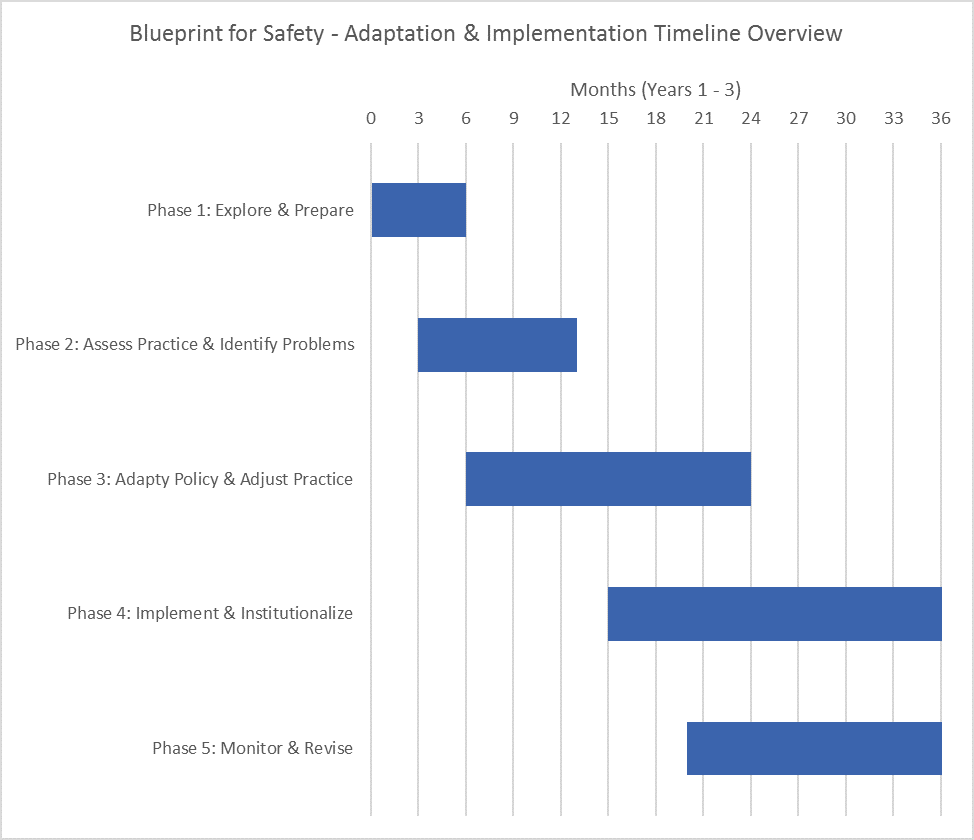 Quick Start Guide
Quick Start Guide
The Blueprint for Safety examines and reorganizes the criminal legal system response to domestic violence crimes. It defines a systematic, unified approach to help stop violence, reduce harm,  and save lives. It is grounded in a shared commitment by system agencies, in partnership with community-based advocates, to identify and solve problems within the framework of the Blueprint principles and process.
and save lives. It is grounded in a shared commitment by system agencies, in partnership with community-based advocates, to identify and solve problems within the framework of the Blueprint principles and process.
If you are reading this guide, you most likely have an interest in building your own Blueprint for Safety. Are you:
- A community-based advocate who has been asked to learn about the Blueprint?
- A police officer or a prosecutor who is curious about how to strengthen your agency’s policy and practice?
- Members of a coordinated community response (CCR) that is curious about how the Blueprint could renew and strengthen its mission?
- A group of advocates and practitioners preparing to persuade agency administrators or the tribal government to become a Blueprint community?
- Affiliated with a family justice or safety center that wonders how the Blueprint might enhance the community’s response to domestic violence?
- Members of a domestic violence fatality review team that is looking for ways to address the gaps that it has discovered in the criminal legal system’s response?
- A newly assigned “Blueprint Team” or “Blueprint Coordinator” with the task of making it all happen?
Whatever your role in exploring or adapting the Blueprint, some basic first steps will help you get familiar with the approach and process, gauge local readiness, decide whether to proceed further, and, depending upon that decision, prepare you to begin and manage the day-to-day work of adapting the Blueprint for your community.
- Spend a few minutes with the Blueprint brochure to get the big picture. You can reproduce the brochure to use in your community. Find the brochure in Appendix 3, Blueprint for Safety Informational Brochure.
- Listen to webinar recordings that present examples of how communities have adapted the Blueprint. The presentations include representatives from St. Paul, MN, where the Blueprint was developed, and New Orleans, LA, the first of the three national adaptation demonstration sites to launch its Blueprint for Safety.
Find the webinars on the Praxis International Blueprint for Safety page. - Review the Essential Commitments and Frequently Asked Questions to get familiar with the Blueprint’s overall features and process.
Find these tools in Appendix 1, Essential Commitments of a Blueprint Community, and Appendix 2, Frequently Asked Questions. Or, see “Becoming a Blueprint Community.” - Complete the Community Readiness Checklist to identify community strengths and pinpoint areas that will need more attention in order to establish the Blueprint.
Find the checklist in Appendix 6 (editable). - Get familiar with the contents of this guide, The Blueprint Guide, and its tools for adapting and implementing the Blueprint for Safety.
A three-year time frame shapes the process of fully adapting and establishing a Blueprint for Safety (see the following overview and the more detailed timeline in Appendix 20). Some communities may require less time, particularly those with a well-functioning CCR that has a history of problem solving together and many Blueprint-ready policies in place. The adaptation guide positions a community to develop and sustain the Blueprint as an ongoing, dynamic process rather than a finite set of tasks. While certain steps are required in a certain sequence—e.g., hire a coordinator and select an adaptation team before adapting and implementing new policy and practice—the Blueprint is fundamentally an approach to intervening in domestic violence crimes in a specific way with specific goals. That approach does not end when the last task is checked off, but continues as a new, unified way of working together to identify and solve problems on behalf of victims of battering and the community.
 Adaptation Timeline
Adaptation Timeline
Many activities occur simultaneously to establish a Blueprint for Safety. Particularly in moving from one phase to another, planning steps are likely to overlap. For a more detailed picture, see Blueprint Adaptation Tasks and Timeline, Appendix 20.

 Who’s Who in Adapting the Blueprint?
Who’s Who in Adapting the Blueprint?
As an approach that rests on partnership and coordination between community-based advocacy and the criminal legal system, the Blueprint involves a broad-based group of agencies, individuals, and roles. An individual can fill multiple roles—e.g., organizer, champion, agency liaison, and member of an ad hoc work group—particularly in smaller communities or agencies.
- Organizers

Typically, a mix of community-based advocates and practitioners—often in leadership roles. Blueprint organizers initiate the exploration and adaptation process, secure support from agencies and champions, write the grants, and manage or participate in activities related to securing a memorandum of understanding, hiring the Blueprint coordinator and advocate, assembling the adaptation and implementation teams, and sustaining the process. Organizers are likely to serve on Blueprint teams and ad hoc work groups, particularly in smaller communities.
- Champions
Advocacy leaders, agency heads, and other influential voices in the agency and the community who support the Blueprint, encourage and promote its development, and help to sustain it over time, although without necessarily being involved in the day-to-day activities of adaptation, implementation, and monitoring. Champions can be agency or organizational leaders or individual practitioners who are influential with their colleagues. A respected 911 call-taker or police sergeant or probation supervisor, for example, can be a Blueprint champion.
- Coordinator
Manages the overall process and tasks involved in adapting and implementing the Blueprint. The coordinator provides the glue and guidance that helps the partner agencies and work groups assess current practice, adapt the Blueprint to local conditions, implement and monitor the resulting changes
in practice, keep battered women’s experiences central to the process. Most communities will require a full-time coordinator.
- Advocate
The leadership by and involvement of community-based advocacy are central to the Blueprint for Safety. Through its defined role, the position of Blueprint advocate is one part of advocacy voice and representation, but it is by no means the only avenue. The Blueprint advocate helps ensure the direct participation of community-based advocates throughout all phases of developing the Blueprint. The position of Blueprint advocate means that it is clearly someone’s responsibility to engage with a wide range of community members, from victims and survivors and community-based advocates to populations overrepresented and/or underserved in the criminal legal system. The Blueprint advocate fulfills that role in consultation with the coordinator, who may also bring experience or affiliation with community-based advocacy. In some smaller communities, the coordinator and advocate roles may be combined into one position.
- Agency liaisons
Representatives appointed by each criminal legal system agency to work with the Blueprint coordinator and participate in all phases of Blueprint adaptation. Under the Memorandum of Understanding, each agency agrees to assign a lead person (or more) as an agency liaison. As members of the adaptation and implementation teams, agency liaisons assist in organizing and conducting the practice assessment, writing policies, collecting data, and overseeing internal agency implementation of the agreed-upon Blueprint policy and practice.
- Adaptation and implementation teams
The adaptation team develops the Blueprint for Safety collective policy. Members include the Blueprint coordinator, advocate, and agency liaisons, plus community-based advocates and representatives for organizations working on behalf of marginalized communities. The adaptation team then transitions to an implementation team that puts the local Blueprint into practice and ensures that the intended goals and practices of the collective policy are being met. Most or all of the same individuals and representatives who served on the adaptation team are likely to continue on the implementation team. Both teams convene small, ad hoc interagency groups as needed (typically, two to six members) to complete the tasks involved in developing and sustaining the Blueprint.
- Agency supervisors
Once each agency’s Blueprint policy is approved and implemented, regular supervisory quality and compliance review of agency practice is crucial to maintaining the Blueprint. Without regular monitoring and oversight, practice tends to drift. Consequently, agency supervisors have a key, ongoing role in sustaining the Blueprint. Beyond their internal role, agency supervisors also contribute to the monitoring, evaluation, and maintenance of the Blueprint as a collective policy by participating in periodic interagency reviews.

